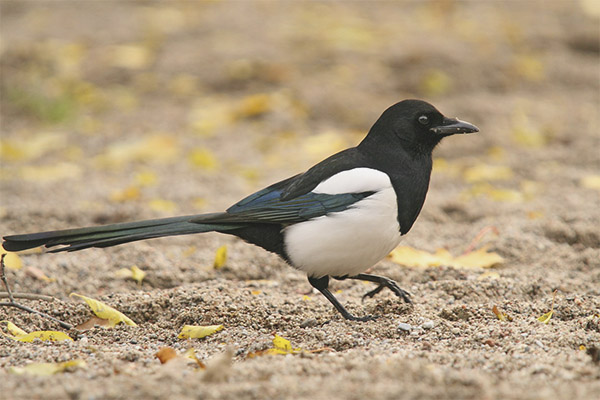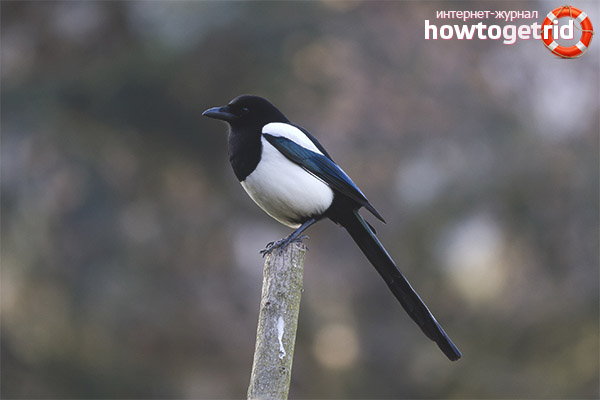The content of the article
Forty ordinary belongs to the most common species of birds that live on the territory of our country. This representative of the Voronov family in adulthood reaches impressive sizes: lengths up to 45 cm, and weights up to 250 g and more. The external data of this amazing bird also attracts, because its plumage in black and white contrasting colors looks impressive. But the most striking is the play of shades on different parts of the body: for example, the plumage of an elongated tail casts a greenish color, and deep blue tones dominate on the wings. The rest of the bird's body is completely black, only the abdomen and lower part of the chest are painted white. White shade have small stripes on the shoulders.
Habitat
In general, forty ordinary likes to settle close to human habitation.Therefore, the nests of this bird are often found in urban parks, squares, forest-park area, and even man-made gardens. The magpies do not like deaf forests and rarely arrange a dwelling there. Birds of this species are found in the European part of the continent, in Asia, in the north of Africa, and also in North America. It should be noted that the birds living in the east of the Eurasian part of Russia are smaller. An ordinary manner of flight gives to an ordinary soroku - the bird chooses only a direct trajectory of movement, and after landing, proudly and even gracefully moves along the ground in dancing steps.
Magpie species
Representatives of a certain breed live in different regions. Here is a list of the most common varieties of the varietal family:
- Siberian blue;
- Himalayan green;
- Chinese azure;
- spanish blue;
- red-billed azure.
In principle, the name of the species makes it easy to understand where it is more common. But this does not always reflect reality. For example, long-tailed magpies like to settle in the forests of South Asia.
Nesting features
Magpies prefer to live in pairs. And these birds are devoted to their partner all their life. They are also distinguished by the mastery of the dwelling, that is, the nest. In the construction process both birds take an equal part. Forty nests have a spherical shape, and for its construction they use foliage, branches, and clay. The inside of the nest is lined with grass, straw, and fragments of other animals' hair. It is worth noting here that the forty ordinary decorates its dwelling according to all the laws of the construction business: the nest necessarily has an entrance located on the side, there is a building and a roof protecting the birds from bad weather.
Magpies nest in separate pairs, as well as small colonies. As a rule, they equip their dwellings at a decent height, and this is done for the purpose of safety during the hatching chicks. Typically, the female - forty lays 5-8 eggs, which have a characteristic bluish-green color. The process of breeding chicks lasts 18-20 days. Throughout this period, the mother of forty does not leave the nest and very carefully protects the future offspring. In general, forty have a very strongly developed instinct for motherhood.These birds are the most caring parents among birds. But the future father of the family also does not mess around: he supplies her friend with food and protects his nest.
After the birth of the chicks, another four weeks gain strength in the nest. Only after this period expires, parents are allowed to do test flights. Parents protect their offspring, feed the chicks until they are fully mature.
The food is delivered to the nest by adult members of the female of the family. Forty ordinary is not too picky in food. These birds consume:
- snails;
- worms;
- various beetles;
- nestlings of small birds (tits, finches).
If the food base in the habitat is scarce, then the magpies decide to destroy other people's nests. But, when there is enough food for chicks, these birds are not engaged in robbery.
Remarkable traits magpie
The forty ordinary, like the crow, is distinguished by intelligence and intellect. And this bird is very curious, it likes to follow and observe. Forty always thinks about her actions, she is able to assess the situation.Any changes around the alarming bird immediately, and, noticing the danger, she immediately begins to make shrill sounds. It is a loud shout of forty signifies to the congeners about the approach of danger. It is important to emphasize here that the shouting cry is also alarming to other animals and birds. Therefore, the magpie is sometimes called the forest scout. Probably, it was from here that the famous proverb about the news that “forty brings on the tail” went.
By the way, the tail of the magpie also performs a special function: when it sits on a branch, it twitches. This behavior in other members of the avian family is not observed.
In addition to the listed characteristics for magpie characteristic:
- High activity.
- Love to change habitat.
- Increased caution, because of which she avoids close contact with a person.
- Curiosity, prompting her to look into other people's nests.
- The ability to make long-distance flights, to which the bird is usually solved for the sake of the desire to find a treat.
There is an opinion that the magpie is able to steal jewelry and shiny items. Of course, the bird can steal the thing she liked, but she would venture on such an act if she does not threaten anything.In other situations, forty will not risk his own life for the sake of an incomprehensible trinket.
Food diet magpies
As noted earlier, the forty ordinary is satisfied with the food supply, which is near. It mainly consumes insects and small animals. The usual menu of the bird are:
- frogs;
- snails;
- lizards;
- locust;
- beetles;
- slugs.
He loves forty to eat vegetable food: seeds, grains, nuts, small fruits.
Forty will not refuse a piece of meat, if such an accident falls out. During the nesting period, when there is a need for more high-calorie food, magpies steal eggs of small songbirds or eat their chicks. True, the magpie is able to attack only single birds, because, living in flocks, the birds can give a serious rebuff to the predator.
Do not shun forty carrion and food waste, it is often fed by visiting the feeders. When it comes to food, forty sometimes shows frank arrogance, stealing food directly from under the nose of the main forest predators - a bear or a fox.
In this regard, it is interesting behavior of black forty, living in the north of Africa. Birds of this species, in search of food, move en masse to pastures, where they set up temporary “parking” on the backs of cattle. Moreover, animals perceive such an act of birds, calmly, because magpies, like some other birds, cleanse their hair of parasites and other pests.
Enemies of magpie
Although forty ordinary itself is a threat to many representatives of the fauna, it also has enemies. In this list:
- owl;
- hawk;
- kite;
- eagle;
- eagle;
- falcon;
- owl;
- wild cat;
- marten.
Magpies living in the tropics are subject to constant snake attacks. True, thanks to the intelligence of these birds, they often manage to avoid danger.
Interesting facts about life forty
The mention of magpie is found in the cultural heritage of different nations. Thus, the Indians of North America believed that the bird is associated with forest spirits. Residents of eastern Asia have always been to the Forty with honor and respect. For centuries they have believed that this bird brings happiness.In Europe, on the contrary, the attitude towards the forty is negative, especially among farmers. This is due to the fact that these birds constantly attack gardens and fields.
But in Taiwan, the blue-faced azure magpie is a symbol. Unfortunately, today this unique species is on the verge of complete extinction due to the destruction of the natural habitat for the bird. Therefore, measures are being taken to restore the number of this rare population.
The results of the scientific research of ornithologists are interesting. They proved that the magpie is capable of performing complex social rituals, which confirms the high intelligence of the bird. A magpie can even recognize his own reflection in a mirror and express emotions.
There is one more positive feature of these restless birds - the ability to heal. Cleansing the skins of domestic animals and livestock from various parasites and insects, magpies save them from many diseases.
Video: forty (pica pica)













To send